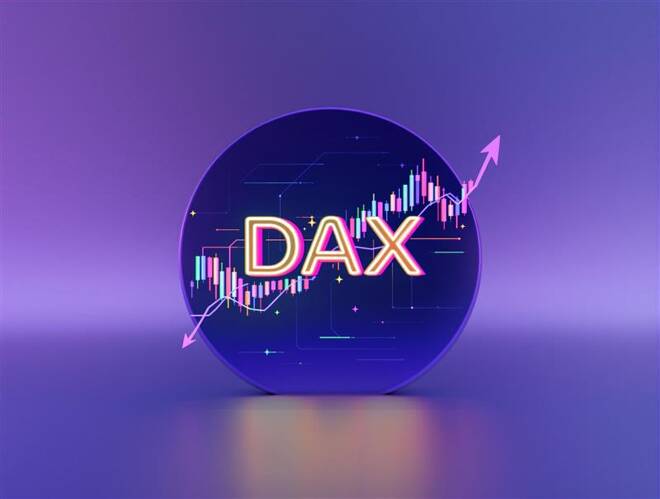Advertisement
Advertisement
Dax Index News: Forecast Turns Bullish on Trade Optimism and Softer Inflation
By:
Key Points:
- DAX rallied for a seventh day on April 30, supported by ECB rate cut bets and optimism on trade and inflation developments.
- US data shows economic contraction and weaker jobs data, fueling Fed rate cut speculation and risk appetite.
- Trade headlines set the DAX up for a breakout Friday session, with DAX Futures up 324 points pre-open.
DAX Eyes Eight-Day Surge on Trade Headlines
The DAX soared for a seventh straight session on Wednesday, April 30, climbing 0.32% to 22,497. Corporate earnings and crucial economic indicators from the Euro area and the US boosted risk sentiment as investors monitored trade headlines. German markets were closed on May 1 for the Labor Day holiday.
Auto Stocks Cap Gains
Auto stocks stumbled on April 30 after Volkswagen reported a 37% slump in Q1 profits, and Stellantis withdrew its full-year guidance, citing tariff uncertainty. BMW slid 2.90%, while Mercedes-Benz Group and Volkswagen fell 2.73% and 2.43%, respectively.
Adidas and online retailer Zalando tumbled 4.13% and 5.22%, respectively, after Adidas warned of potential price hikes because of US tariffs.
Meanwhile, Airbus gained 2.14% on upbeat earnings, with MTU Aero and Rheinmetall rising 3.13% and 1.47%, respectively.
German Inflation Boosts ECB Rate Cut Bets
Germany’s annual inflation rate eased from 2.2% in March to 2.1% in April, supporting bets on multiple ECB rate cuts. A more dovish ECB rate path could lower borrowing costs and weaken the EUR, potentially raising corporate earnings. A softer EUR could also improve the competitiveness of export-focused German-listed firms.
Weaker-than-expected US economic data also fueled speculation about a more dovish Fed stance, supporting risk appetite. The US economy contracted by 0.3% in Q1 2025 after expanding by 2.4% in Q4 2024.
Eurozone Inflation to Spotlight the ECB
On Friday, May 2, Eurozone inflation figures will influence the ECB rate path and risk assets. Economists forecast the annual inflation rate to ease from 2.2% in March to 2.1% in April. A softer reading could further fuel speculation about ECB rate cuts, potentially boosting demand for rate-sensitive stocks.
US Markets Jump on Earnings and Fed Bets
Meta Platforms (META) and Microsoft (MSFT) surged on Thursday, May 1, amid rising US recession risks. US equity markets advanced as investors reacted to corporate earnings reports and US economic data. The Nasdaq Composite Index jumped 1.52%, while the Dow and the S&P 500 rose 0.21% and 0.63%, respectively, marking eight straight sessions of gains.
Meanwhile, signs of economic slowdown supported dovish Fed expectations. Initial jobless claims rose to 241k (week ending April 26), up from 223k (week ending April 19). The ISM Manufacturing PMI fell from 49 in March to 48.7 in April, remaining below the crucial 50 neutral level.
US Jobs Report in Focus
Later today, the US Jobs Report will influence Fed rate cut expectations.
Rising wages, falling unemployment, and a jump in nonfarm payrolls may temper expectations of a more dovish Fed rate path. Higher wages could fuel consumer spending and demand-driven inflation. A less dovish Fed rate path may impact risk assets.
Conversely, slower wage growth, rising unemployment, and a slump in nonfarm payrolls may fuel recessionary fears and raise Fed rate cut bets. A more dovish Fed stance could boost demand for risk assets.
Trade headlines also remain critical. Reports that China may resume trade negotiations lifted Asian equities and DAX futures during Friday’s Asian session. Easing US-EU and US-China tensions would support a relief rally. However, renewed tensions may overshadow central bank rate cut bets, impacting risk sentiment.
DAX Outlook: Macro and Central Banks in Play
The DAX’s near-term outlook hinges on key economic indicators, central bank commentary, and trade developments.
- Bullish Case: Easing trade tensions, softer economic data, and dovish central bank guidance could send the DAX toward 22,750.
- Bearish Case: Rising trade tensions, higher inflation and labor market data, or hawkish central bank rhetoric may drag the DAX toward 22,000.
As of Friday morning, the DAX futures jumped 324 points, while the Nasdaq 100 mini rose 108 points, indicating a positive start to the session.
Technical Setup: Cautious Optimism
According to the daily chart, the DAX remains above the 50-day and the 200-day Exponential Moving Averages (EMA), underscoring bullish momentum.
- Upside Target: A break above the April 30 high of 22,607 could pave the way to 22,750. A decisive breakout may enable the bulls to target 23,000.
- Downside risk: A break below 22,350 may trigger a fall toward 22,000 and the 50-day EMA.
Conclusion: Monitor Macro Themes
DAX traders should monitor Eurozone inflation, US jobs data, ECB commentary, earnings, and trade developments. These factors will likely influence market sentiment and direction in the near term.
Click here to explore our latest DAX research, macro insights, and emerging market coverage.
About the Author
Bob Masonauthor
With over 28 years of experience in the financial industry, Bob has worked with various global rating agencies and multinational banks. Currently he is covering currencies, commodities, alternative asset classes and global equities, focusing mostly on European and Asian markets.
Advertisement
